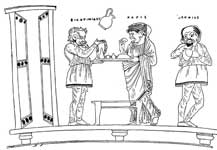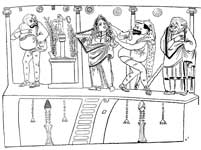.
Rhinthon (Ῥίνθων ), of Syracuse or Tarentum (c. 323-–285 B.C.), a dramatic poet, of that species of burlesque tragedy, which was called φλυακογραφία or ἱλαροτραγῳδία, a burlesque of tragic subjects, flourished in the reign of Ptolemy I. king of Egypt (Suid. s. v.). When he is placed by Suidas and others at the head of the composers of this burlesque drama, we are not to suppose that he actually invented it, but that he was the first to develope in a written form, and to introduce into Greek literature, a species of dramatic composition, which had already long existed as a popular amusement among the Greeks of southern Italy and Sicily, and especially at Tarentum. He was followed by other writers, such as SOPATER, SCIRAS, and BLAESUS.
The species of drama which Rhinthon cultivated may be described as an exhibition of the subjects of tragedy, in the spirit and style of comedy. It is plain, from the fragments of Rhinthon, that the comic licence extended to the metres, which are sometimes even more irregular than in the Attic comedians (Hephaest. p. 9, Gaisf.). A poet of this description was called φλύαξ. This name, and that of the drama itself, φλυακογραφία, seem to have been the genuine terms used at Tarentum.
Of the personal history of Rhinthon we know nothing beyond the statement of Suidas, that he was the son of a potter. He is said to have written thirty-eight dramas (Suid. s. v.; Steph. Byz. s. v. Τάρας), of which we still possess the following titles: Ἀμφιτρύων, Ἡρακλῆς, Ἰφιγένεια ἡ ἐν Αὐλίδι, Ἰφιγένεια ἡ ἐν Ταύροις, Ὀρέστης, Τήλεφος. He is several times quoted by Athenaeus, Hesychius, and other Greek writers, and by Cicero (ad Att. i. 20), and Varro (R. R. iii. 3. § 9).
One of the Greek grammarians tells us that Rhinthon was the first who wrote comedy in hexameter verse; the meaning of which probably is, that in his dramas the dactylic hexameter was largely used, as well as the iambic trimeter (Io. Lydus, de Magistr. R. i. 41). The same writer further asserts that the satire of Lucilius sprung from an imitation of the comedy of Rhinthon, just as that of the subsequent Roman satirists was derived from the Attic comedians; but to this statement little credit can be attached.
The Greek anthology (Brunck, Anal. vol. i. p. 196, No. 12.) contains an epigram upon Rhinthon by Nossis. (Miiller, Dorier, b. iv. c. 7. § 6); Osann, Anal. Crit. pp. 69, &c.; Reuvens, Collectan. Litt. pp. 69, &c.; Jacobs, Animadv. in Anth. Graec. vol. i. pt. i. p. 421; Fabric. Bibl. Graec. vol. ii. p. 320; Clinton, F. H. vol. iii. p. 486.)
Scenes from these travesties are probably represented in certain vase paintings from Lower Italy, for which see H. Heydemann, "Die Phlyakendarstellungen auf bemalten Vasen," in Jahrbuch des archäologischen Instituts, i. (1886).
Fragments in monograph by E. Volker (Leipzig, 1887) ; see also E. Sommerbrodt, De Phlyacographia Graecorum (Breslau, 1875) ; W. Christ, Geschichte der griechischen Litteratur (1898).
References
This article incorporates text from the 1911 Encyclopædia Britannica, which is in the public domain.
| Ancient Greece
Science, Technology , Medicine , Warfare, , Biographies , Life , Cities/Places/Maps , Arts , Literature , Philosophy ,Olympics, Mythology , History , Images Medieval Greece / Byzantine Empire Science, Technology, Arts, , Warfare , Literature, Biographies, Icons, History Modern Greece Cities, Islands, Regions, Fauna/Flora ,Biographies , History , Warfare, Science/Technology, Literature, Music , Arts , Film/Actors , Sport , Fashion --- |
Retrieved from "http://en.wikipedia.org"
All text is available under the terms of the GNU Free Documentation License



